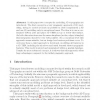Free Online Productivity Tools
i2Speak
i2Symbol
i2OCR
iTex2Img
iWeb2Print
iWeb2Shot
i2Type
iPdf2Split
iPdf2Merge
i2Bopomofo
i2Arabic
i2Style
i2Image
i2PDF
iLatex2Rtf
Sci2ools
COSIT
2005
Springer
2005
Springer
3D Topographic Data Modelling: Why Rigidity Is Preferable to Pragmatism
In this paper two concepts for modelling 3D topography are introduced. The first concept is a very pragmatic approach of 3D modelling, trying to model as much as possible in (less complicated) 2.5D and use 3D modelling only in exceptional cases. The idea is to use a constrained TIN in 2.5D and place 3D TENs on top or below this surface. As both data structures use the same simplexes (nodes, edges, triangles) this integration should be very well possible. At a conceptual level this approach seems suitable, but at design level serious problems occur. To overcome these a rigid approach is developed, modelling all features in a 3D TEN, including the air above and earth beneath these topographic features. This model is stored and maintained within a spatial database. Despite its more advanced concept, it is shown that this approach offers huge advantages compared to the initial pragmatic approach.
| Added | 26 Jun 2010 |
| Updated | 26 Jun 2010 |
| Type | Conference |
| Year | 2005 |
| Where | COSIT |
| Authors | Friso Penninga |
Comments (0)

